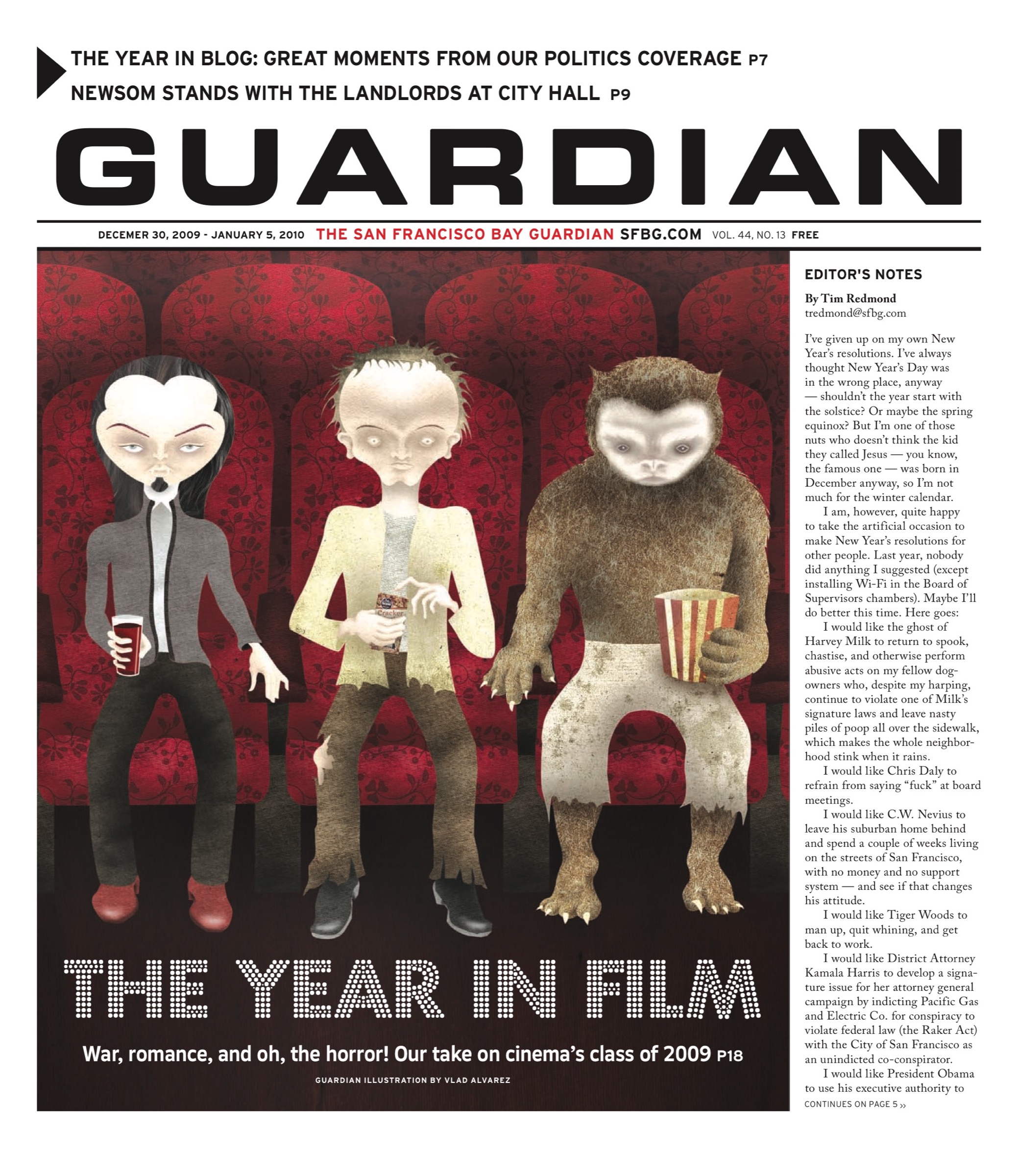It’s tough out there. The recession is supposed to be over, although you’d never know it to walk the streets of San Francisco. But we’re here to help; our Hard Times Handbook offers tips on bargains, deals, and discounts to make those fewer dollars go further.
———-
Broke doesn’t mean bored
Eight great ways to have fun in San Francisco for $5 or less
By Johnny Funcheap
Living on a tight budget and still trying to have fun in San Francisco is a near impossible task. This is an expensive city, thanks to the reality that everyone wants to live in the tiny 49-square-mile cultural oasis — driving up rents and the cost of just about everything else.
Despite its reputation, the city is actually getting slightly more affordable, if ever so relatively. (In 2008 San Francisco actually fell in the rankings of most expensive cities in the U.S. from fourth to fifth.)
Leading the charge toward making the city a more affordable place to have fun are numerous businesses, government-run sites, and co-ops that are trying to survive in the recession themselves — and using big discounts and fun free events to try to lure you in.
Here’s a list of my favorite deals and freebies I’ve found so far for 2010.
CAFÉ ROYALE
Waving the flag high for nightlife in the Trendynob with its curved couches and velvet curtains is the cozy beer and wine bar Café Royale. This late-night venue (it’s open until 2 a.m. Fridays and Saturdays) stages more than 20 nights of free events each month, an eclectic mix of live entertainment that includes jazz bands, Beatles karaoke, book readings, slam poetry, stand-up comedy, and even the odd accordion night. You can dine on small plates and noshables until the wee hours, and wash them down with a robust selection of wines by the glass and creatively yummy Soju cocktails like the Pom Pom and Creamsicle. And for billiards fans, Café Royale has one of the few three-quarter size tournament tables in San Francisco at just 75 cents a game.
800 Post at Leavenworth. 415-441-4099. www.caferoyale-sf.com
COUNTERPULSE
More an arts and culture community hub than just a performance space, CounterPULSE serves as a home and venue for a diverse mix of local artists, dancers, and playwrights to practice and showcase their latest works. A majority of the events at this nonprofit theater (plays, dance performances, as well as classes and workshops) are free. For more elaborate productions that require tickets, CounterPULSE has a wonderful “no one turned away for lack of funds” policy. You can also get in free by donating a few hours of your time to the volunteer usher program.
1310 Mission at Ninth St., 415-626-2060. www.counterpulse.org
$5 MOVIE NIGHT
Saving money on going out to the movies used to mean you had to blag your way to a cheap ticket using a long-expired student ID or arrive by lunchtime to save a few bucks on a matinee ticket. The historic Roxie Theater has done away with all of those shenanigans, at least on Monday nights, with cheaper-than-matinee prices ($5) to all films (except for the odd film festival or special screening when regular ticket prices still apply). This stalwart of the Mission District, which recently celebrated its 100th birthday, is an independent art-house theater that shows limited-run art, music, foreign, and documentary films on two small screens.
Roxie Theater, 3117 16th St., 415-431-3611. www.roxie.com
BART DISCOUNTS AND FREE RIDES
You didn’t think BART — notoriously expensive for commuters — could be the source of cheap events, did you? Well, mybart.org, run by the transit system, lists a calendar of free events that take place close to BART stations. The site also gives you access to an constantly updated bevy of special discounts like two-for-one theater tickets, museum discounts, and heavily-discounted tickets to Warriors and Cal basketball games. For those of you who only respond to free, mybart.org also puts together ticket contests with different prizes each week, like the chance to win one of five preloaded $50 BART tickets.
PIER CRABBING
Hell with Fisherman’s Wharf and its giant crab sign. Forget the pricey crab dinners at local restaurants. You can learn how to be your own crusty crab-fisher, right in the shadow of the Golden Gate Bridge. The National Park Service staffers at the historic Fort Port (built in the 1850s) give free pier-crabbing demonstrations every Saturday morning from March to October. After the class, they’ll even loan you crabbing equipment so you can put your newly-learned skills to the test. Space is limited and advanced reservations are required.
Fort Point, Marine Drive, Saturdays, 10 a.m.–noon, March–Oct. (415) 556-1693 www.nps.gov/fopo
THE HISTORY OF BAY AREA ROCK ‘N’ ROLL
Feeling nostalgic? You can get a taste for the era when the Bay Area and the psychedelic music scene were the center of the rock ‘n’ roll universe at the Museum of Performance and Design’s free history exhibit “Something’s Happenin’ Here: Bay Area Rock ‘n’ Roll 1963-73.” On display at this one-of-a-kind exhibit are the full-size original painting that made in onto the Grateful Dead’s “Anthem in the Sun” album cover, costume pieces worn by stars like Janis Joplin and Sly Stone, and original posters from the Fillmore and the Avalon Ballroom, along with a collection of previously unseen rock photos. Visitors can also listen to rare audioclips and watch vintage film footage they probably never knew existed. Exhibit runs through Aug. 28. It’s free, but the museum suggests a $5 donation.
Museum of Performance and Design, Veterans Building, 401 Van Ness, Fourth Floor. Wed.–Sat., noon–5 p.m. www.mpdsf.org
AMERICAN BOOKBINDERS MUSEUM
If you’re really looking for a blast from the past, check out the free exhibit at this little-known museum. Bookbinding is the art of physically assembling and sewing the pages and spine of a book by hand — a skill that was made essentially obsolete (at least, for the purpose of mass-production) with the dawning of the Industrial Revolution. But the nonprofit American Bookbinders Museum, part of a working bookbindery that still practices this art, documents the history of how books used to be put together with exhibits celebrating the skilled artisans who bound books, samples of vintage papers, and a maze of large and terrifying-looking 19th- and early 20th-century binding and cutting machines (many of which could cut off all your fingers in one go if you stood too close).
1962 Harrison at 16th St., Saturdays, noon–4 p.m. and by appointment, (415) 710-9369. www.bookbindersmuseum.com
SAN FRANCISCO BICYCLE COALITION
Unless you want to walk, there’s really no cheaper way to get around town than on a bicycle. And for the tens of thousands of San Franciscans who use bikes as their main mode of transportation, the Bike Coalition is a co-op knight in shining armor. The advocacy group, whose members successfully fought more than 200 miles of bike lanes in the city as well as bike access on Muni and BART, also puts on and sponsors a handful of events each month such as free urban cycling workshops to help you navigate the city streets safely, themed guided bike rides, and many other bike-friendly events. Membership starts at $35 per year, but many of their events are free for nonmembers or for a $5 donation.
D-STRUCTURE
Owned by former pro skater and X-Games judge Azikiwee Anderson, D-Structure in the Lower Haight blurs the line between retail store, art gallery and performance space in a big way. Every month, this self-described “lifestyle clothing brand culture store” lets local artists take over the space and use the entire store as their canvas. For launch parties, which take place several times each month, the merchandise displays of urban hoodies and t-shirts and hip beanies are pushed to the walls to make room for DJs and events that range from art openings with live painting to indie rock shows, hip hop album release parties and film screenings. And did we mention the open bar? During its nighttime events, most of which are free and open to the public, D-Structure has been known to bring in a truck load of beer; that’s what happened on New Year’s Eve.
520 Haight, 415-252-8601, Mon.–Sat., noon–8 p.m.; Sundays, noon–6 p.m. www.d-structuresf.com
Johnny Funcheap runs FunCheapSF.com, a free SF-based service that uncovers and shares a hand-picked recommendation list of more than 50 cheap, fun, unique Bay Area events each week.
———-
Drink early and often
Five great happy hours that offer bargain booze — and amazing food deals
By Virginia Miller
BAR CRUDO’S HAPPY HOUR
About the best crudo (and some of the best seafood) anywhere, Bar Crudo’s new digs on Divisadero Street provide ample room for you and your friends. You want to go at happy hour; there’s free food and you can also get sweet deal on what is arguably one of the best seafood chowders around. A creamy bowl rich with fish, mussels, shrimp, squid, potatoes, and applewood-smoked bacon goes for $5 (normally $14). Oysters from British Columbia, Prince Edward Island, and Washington are normally $2.50 each, but only $1 during happy hour. Beer and wine specials rotate, $5 for wine or $3 for beer — and we’re not talking PBR. Bar Crudo is known for a broad selection of Belgian and artisan beers, not to mention some beautiful wines.
Mon.–Thurs., 5–6:30 p.m. 655 Divisadero.415-409-0679. www.barcrudo.com
SEAFOOD HAPPY HOUR AT SWELL
For happy hour with a touch of class — and an affordable price — you can’t beat Swell, a delightful, under-the-radar crudo/seafood restaurant. The post-work crowd gets $1 oysters — and not just any oysters, but our own local Point Reyes’ bivalves. There’s ceviche with kampachi and butterfish or mackerel bruschetta with garlic-ginger oil ($8 each). For imbibing, sip $6 Bellinis and Kir Royals or $6 glasses of chardonnay, syrah, or rosé.
Mon.–Thurs., 5–7 p.m. 603 Bush. 415-956-0396. www.swellsf.com
AVENUE LOUNGE’S FREE BRATS ON SUNDAYS
I’ll give you three words: bacon bloody marys. That alone makes it worthwhile trekking to Outer Sunset’s Avenue Lounge on a Sunday. But it gets better: buy any of the $3 well drinks or draft beers ($5 to upgrade to Belvedere or Hennessy in your cocktail) and they’ll throw in free brats and chips. Yes, you heard right: dogs, beer, and football on the flatscreens for $3. At that price, you could settle in all day.
Sundays, 10a.m.–2 a.m.. 1334 Noriega. 415-731-3757
NAMU’S FREE-FOOD MONDAYS
Monday night is free food night at Namu, the Richmond District’s gem of an Asian fusion restaurant that combines Korean and Japanese cooking techniques with Cali-fresh cuisine. With an order of sake, beer, or glass of wine, you can nibble on what Namu is dubbing “drinking food”: bite-size tapas, skewers, and spreads with Asian flair. If you can’t stay out late on a Monday night, there’s a weekday happy hour from 5-7 p.m.
Mondays, 9:30–10:30pm. 439 Balboa. 415-386-8332.www.namusf.com
DOSA ON FILLMORE’S SOUTH INDIAN HAPPY HOUR
This Pac Heights wing of Dosa has the feel of a chic London Indian restaurant, with striking chandeliers and gorgeous Indian-influenced cocktails. The happy hour rocks with a rotating selection of beer (like India’s Kingfisher), wine (maybe a Dona Paula Argentinean malbec) and, yes, those cocktails (how about “Mood Indigo,” i.e., Buffalo Trace bourbon, jackfruit marmalade, Angostura bitters, and a splash of sparkling wine) for a mere $5 each. For the same price, there’s a range of South Indian snacks like cochin calamari sautéed in coconut milk and served with a julienned salad, or a mung sprout salad with fresh lentils, tomatoes, ginger, cucumber, grated coconut, chile, and mustard-seed oil.
Mon.–Thurs., 5:30–7 p.m. 1700 Fillmore. 415-441-3672. www.dosasf.com.
Virginia Miller writes about food for sfbg.com and offers advice for great meals at theperfectspotsf.com
————
Drinks on the cheap
By Caitlin Donohue
“No nation is drunken where wine is cheap, and none sober where the dearness of wine substitutes ardent spirits as the common beverage.” So said our illustrious forefather and part-time debaucher, Thomas Jefferson, on the importance of happy hour. We are proud of the brave bar-owning San Franciscan souls who have held true to his vision of a nation built on cheap booze and high spirits. Here assembled are their numbers, true patriots that they are.
BAR ON CHURCH
Some days you want to get drunk and throw peanut shells on the floor. This is a practice aided and abetted by the B.O.C., which serves up 50 cent PBR’s (that elixir from the heavens for the broke-as-hell contingent) and free peanuts from 4-8 p.m. on Saturdays. Sit down, throw one back and get nutty with it.
198 Church, SF. (415) 355-9211. www.thebarsf.com
TSUNAMI SUSHI
With more than 100 sake bottles on the menu, Tsunami is usually off-limits to those with holes in their pockets. Not so during happy Hour (Mon.-Fri. 5-8 p.m., Sat. 6-9 p.m.) when all bottles and selected maki rolls are half off. Try the Sho Chiku Bai nigori sake, a sweet, creamy, unfiltered 720 ml that’ll only run you $16 — ureshii yo!
Mon.–Fri. 5–8 p.m., Sat. 6–9 p.m. 301B King, SF. (415) 284-0111. www.dajanigroup.net
EL RIO
Ah, Mondays at El Rio. If shuffleboard and easy access to cheap burritos isn’t enough to pull you Outer Mission-ward, than peep their very special Monday happy hour: $1 Pabsts, $2 wells all the live-long day. Get you in with that and then tell us you can’t hang with the hipster hangouts.
3158 Mission, SF. (415) 282-3352. www.elriosf.com
KYOTO SUSHI
Japanese businessmen have a reputation for sealing big deals utterly, blackout snookered. Something about how you can only really know a man when he’s being slapped by the waitress for being fresh or passed out drooling on your suit jacket. At any rate, sushi restaurants like to get you drunk. Check out Kyoto, where the anytime special of draft Sapporos for 99 cents will compel you to raise one to the salaryman.
1233 Van Ness, SF.(415) 351-1234. www.kyotosushi-sf.com
BRAIN WASH LAUNDROMAT
Now here’s a multitask for you: get drunk, listen to good music, and wash your clothes. Only one spot in the city where that’s a go — and to celebrate the lineup of fresh tunes and clean threads, Brain Wash Laundromat is offering $1 Pabst during happy hour and $3 wine glasses all the time. Drop by for its acoustic open mic nights Tuesdays at 7 p.m.
1122 Folsom, SF. (415) 861-3363. www.brainwash.com
BEAN BAG CAFE
Not only does this sunny, warm café serve the most bangingest breakfast burrito and plethora of bean blends in the city, the folks there have a soft spot for the low-income set. Bean Bag proves it with $1.75 Stella Artois and 21st Amendment beers on tap; just the ticket for easing your way through that mid-afternoon caffeine-booze transition. Just don’t spill on the laptop and you’re golden, you pillar of the community, you.
Bean Bag Café. 601 Divisadero, SF. (415) 563-3634 *
————
How to fight foreclosure
By Caitlin Donohue
You’ve finally found your dream home, an apartment so well-loved even you can afford it. You settled in, cleaned the carpet, set the mouse traps … and then the eviction notice arrives: your landlord’s been foreclosed on. And the bank that owns the place now wants you out.
It’s happening a lot in this city, where tenants get caught in the financial meltdown through no fault of their own. But don’t panic: in most San Francisco buildings, foreclosure isn’t a legal grounds for eviction. But you’ll have to stand up for your rights.
Here’s what the San Francisco Tenants Union advises:
•If you sense your landlord’s at the brink of foreclosure, watch for telltale signs: realtors checking out the property or repairs that go unresolved. Keep in mind that lack of money is no defense for maintaining property, so call the Department of Building Inspections at 415-558-6200 for help with holding property-owners to their repair responsibilities.
•Once the eviction notice due to foreclosure arrives, find out if you are covered by rent control. If you aren’t (if your rental was built after 1979 then you definitely aren’t) the bank has the power to evict you within 90 days. If you do have rent control, you have eviction protection. This means the bank can’t evict you or raise your rent.
Unfortunately, the bank might not know that if it’s based outside the city or state. Ignore the letters to vacate and contact the bank of its property agent directly to let them know you have protection. Then file a wrongful eviction petition with the SF Rent Board, which also handles cases from Oakland, Berkeley and West Palo Alto (forms available at the office at 25 Van Ness, SF or online at www.sfgov.org/rentboard).
•Rent control or no, landlords can only collect rent on foreclosed properties until the deed of trust has gone to the bank. Determine who has control of your property to avoid paying rent twice. This information is available at the City Assessor’s Office at 415-554-7915. Send letters to the bank and to your landlord saying you have the money but don’t know who to pay. Until you can determine who has control, don’t pay rent.
For more resources, check out SF Tenants’ Union Web site at www.sftu.org.
———–
Avoid check-cashing fees
By Caitlin Donohue
ATM charges, big old monthly fees, frustrating commercials — oh Lord, save us from these banks! But you can’t live without ’em either — the average unbanked American spends 5 percent of his or her income at the check-casher. In San Francisco, we drop a total of $40 million a year accessing our own money — not to mention how much goes toward money order fees.
Enter the Bank of San Francisco, the mayor’s brainchild that allows city residents to open a checking or savings account for $5 a month or less. The bank is open to those without Social Security numbers as well as residents who have a poor record with accounts in the past. Go to www.bankonsf.org for more information on the program, or keep an eye peeled for one of the 140 participating city banks that have a “Bank on SF” sign in their window. There’s no reason to pay check-cashing fees any more.
————
Food so cheap, it’s free
Let’s level here: how broke are you? Two-for-one beers and discounted oysters are all well and good for the casually unmonied, but there are times when one needs a real deal on nutrition — like, food that really is free. If we’ve got your number, here’s the Web site for you: www.freeprintshop.org, whose printable calendar lists 20 organizations that dish up meals open to all comers, including Food Not Bombs’ vegetarian dinners, which are served four times a week in U.N. Plaza. Free Print Shop gets the posthumous thumbs-up from Abraham Maslow: the up-to-date info on shelters, mental health, and neighborhood resources in the city has the bottom tier of your hierarchy of needs covered. Except for maybe the sex part; that might be another Web site. (Caitlin Donohue)
————-
Inner peace, by donation
It is said that whenever Buddha would speak to an audience that had not yet recognized him as their spiritual teacher, he would first expound on the concept of dana, or giving. If the listeners were unable to grasp this basic principle, he knew they weren’t ready for the Four Noble Truths.
Would that all yoga studios were this enlightened. I mean, $20 for 90 minutes of inner peace?
We are lucky that with a little bit of looking one can find financially accessible ayurveda even here, in the city of yoga-yuppies. Case in point: Yoga to the People, whose beautiful new Mission District studio (and fixture Berkeley location) offers three classes a day by donation, some of them by candlelight and all of them dana approved. And they’re not the only ones. Here’s a list of places that will relieve that tension you’ve been holding, including the strain in your wallet. (Caitlin Donohue)
YOGA TO THE PEOPLE
Class schedule online, donations
2673 16th St., SF
64 Shattuck, Berkeley
GREY AREA FOUNDATION FOR THE ARTS
Mondays, 6-7:30 p.m., donations
55 Taylor, SF
SPORTS BASEMENT
Sundays, 1-2:30 p.m., free
1590 Bryant, SF
(415) 575-3000
LAUGHING LOTUS
Mon.-Fri. 2:30–3:45 p.m., donations
3261 16th St., SF
(415) 335-1600
SATORI YOGA STUDIO
Mondays, 4:15– 5:15 p.m., free
40 First St., SF
(415) 618-0418
PURUSHA YOGA
Saturdays, 11 a.m., free
Main entrance of Botanical Gardens
Golden Gate Park
Ninth Ave. and Lincoln Way, SF
(415) 694-8412
————
Learning to love the rec centers
With free gyms, darkrooms, and play areas, city rec centers may be the athlete (or artist’s) answer to the bum economy
By Molly Freedenberg
I’ve always though of recreation centers as places where kids took cheap summer camp classes or attended awkward junior high school dances. But these city-funded centers are actually some of the coolest, most affordable, and least appreciated resources any community has to offer — and especially so in San Francisco.
From weight rooms and basketball courts to dance studios, dog parks, and performance-ready auditoriums, SF’s neighborhood centers offer a variety of resources for budget-conscious adults as well as their kids. Use of most facilities is free (or, on rare occasions, costs a nominal fee) and classes and workshops are priced low with a sliding scale and scholarship option.
Why does the city allocate $34.5 million in general fund support to maintain these centers every year? According to Elton Pon, spokesperson for the Recreation and Park Department (which also oversees public spaces like Golden Gate Park and Coit Tower), “they keep the city sane.”
We’ve outlined the resources at some of our favorite centers, but check parks.sfgov.org for a full list, sfreconline.org for programs, or call (415) 831-5520 for information on renting rec center buildings.
CHINESE RECREATION CENTER
This Nob Hill neighborhood center caters primarily to youth in Chinatown, which is most apparent weekdays after 3 p.m. when its gym areas fill up with teenage boys. But everyone can enjoy volleyball, basketball, and even dance in its indoor gym, outdoor hoops, and mini weight room. The secret to getting some grown-up time? Visit early on weekdays or after 7 p.m.
1199 Mason. (415) 292-2017
EUREKA VALLEY REC CENTER
Well-maintained and recently renovated, this Castro District facility is a favorite for its resources and fantastic location (there’s a grocery store right next door, not to mention the full Castro shopping corridor a block away). Parents love that the indoor and outdoor play areas are especially good for toddlers. Dog-owners love the enclosed dog run. Sporty adults appreciate that the basketball court is regularly relacquered, while event planners focus on the auditorium with raised stage and 70-seat capacity. Special bonuses? An LGBT Teen Center and an especially girl-friendly gym scene.
100 Collingwood. (415) 831-6810
HARVEY MILK ARTS CENTER
Geared more toward artists than athletes, this recently reopened center in Duboce Park is a dream-come-true for creative-leaning folks on a budget. With dark room, dance studio, costume room, meeting spaces, and variety of other opportunities, HMAC is a fantastic and affordable alternative to adult education courses, expensive dance studios, and booked-up theater spaces.
50 Scott. (415) 554-9523
MISSION REC CENTER
This hidden gem, often overlooked by athletes headed to Mission Cliffs, offers everything your K-12 schools did — without the homework or early call-time. Mission Rec provides a weight area, ping pong tables, squash courts, a dance studio (complete with floor-to-ceiling mirrors and enclosed storage space), basketball court, outdoor playground area, and a full auditorium with stage and curtains (and food prep area).
2450 Harrison. (415) 695-5014
POTRERO HILL REC CENTER
Most people notice the baseball fields first — a full-block expanse of green, grassy oasis in the center of what’s still mostly an industrial area. But this city property also offers a well-maintained indoor basketball court, recently revamped playground, decent tennis courts (though lights rarely work), and a dog-friendly area that notoriously extends to the rest of the park when games aren’t in session. Not feeling sporty? Check out the infamous mural of O.J. Simpson (who apparently used to frequent the park as a kid) or the fantastic view of the city and the bridge from the south/southeast end of the park.
801 Arkansas. (415) 695-5009
RICHMOND REC CENTER
Catering primarily to the very young and the very old, people in the middle can certainly appreciate this classic neighborhood meeting spot. Play badminton, volleyball, or take advantage of the dance studio (where many city dance programs are held). Or just people-watch: weekdays are great for spying toddlers in the big indoor play area or quieter play-and-craft spot; weekends are when older Asian ping pong masters take over.
251 18th Ave. (415) 666-7020
UPPER NOE REC CENTER
Newish, bright, and clean, this well-loved and well-funded facility also is one of the few with its own Web site (hosted by friends of the Noe Valley Recreation Center). The bright, shiny spot offers indoor and outdoor basketball courts, a playground, baseball field, tennis court, dog park, and (according to parents-in-the-know), an inordinately nice sandbox. Indeed, this spot is known for being especially good for babies and toddlers. Another bonus? A multipurpose room that can be rented for small events features an A/V system, stage area with upgraded theater curtains, and a large movie screen with a projector.
30th Sreet, west of Church. (415) 695-5011. www.noevalleyreccenter.com








